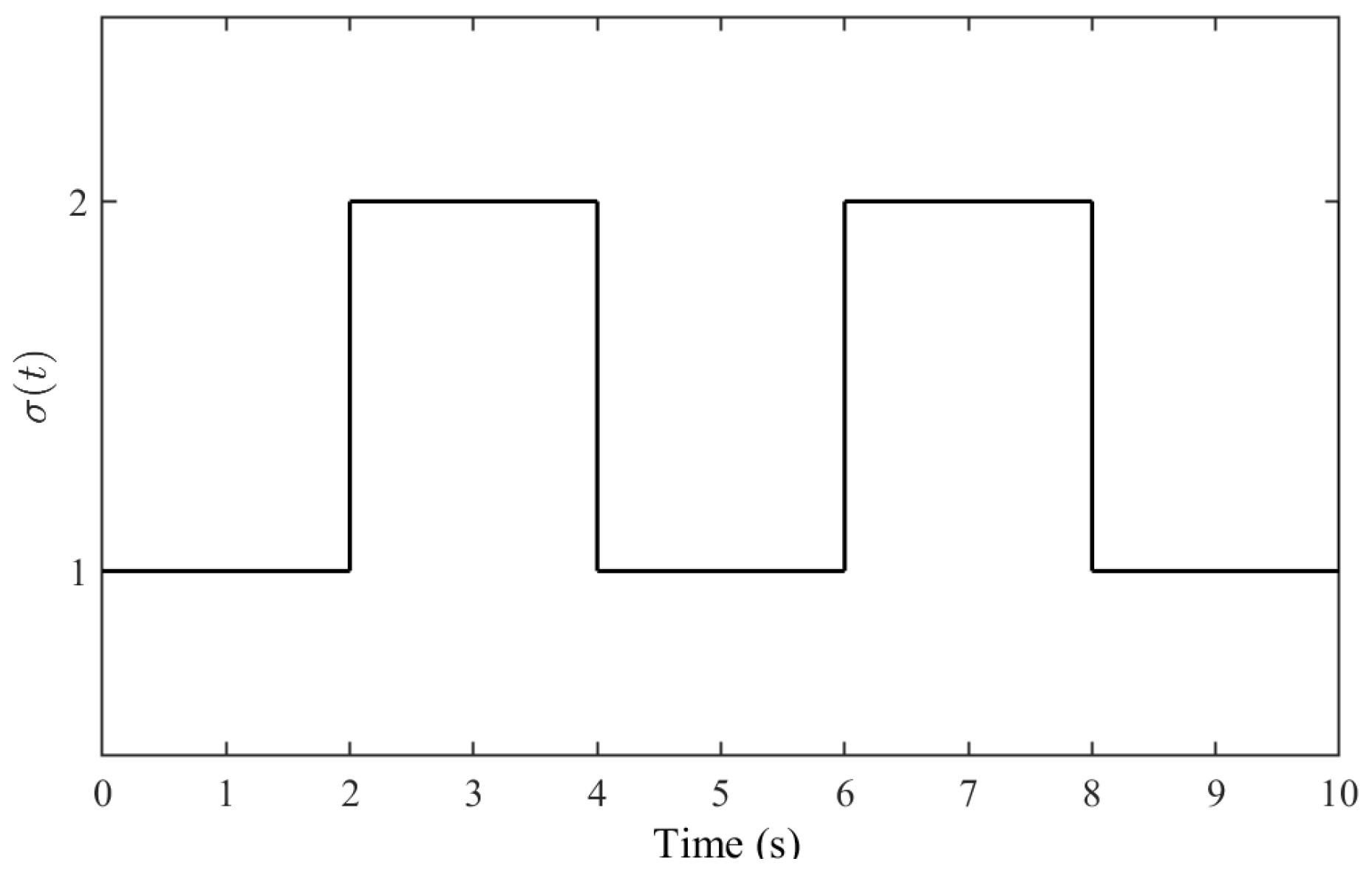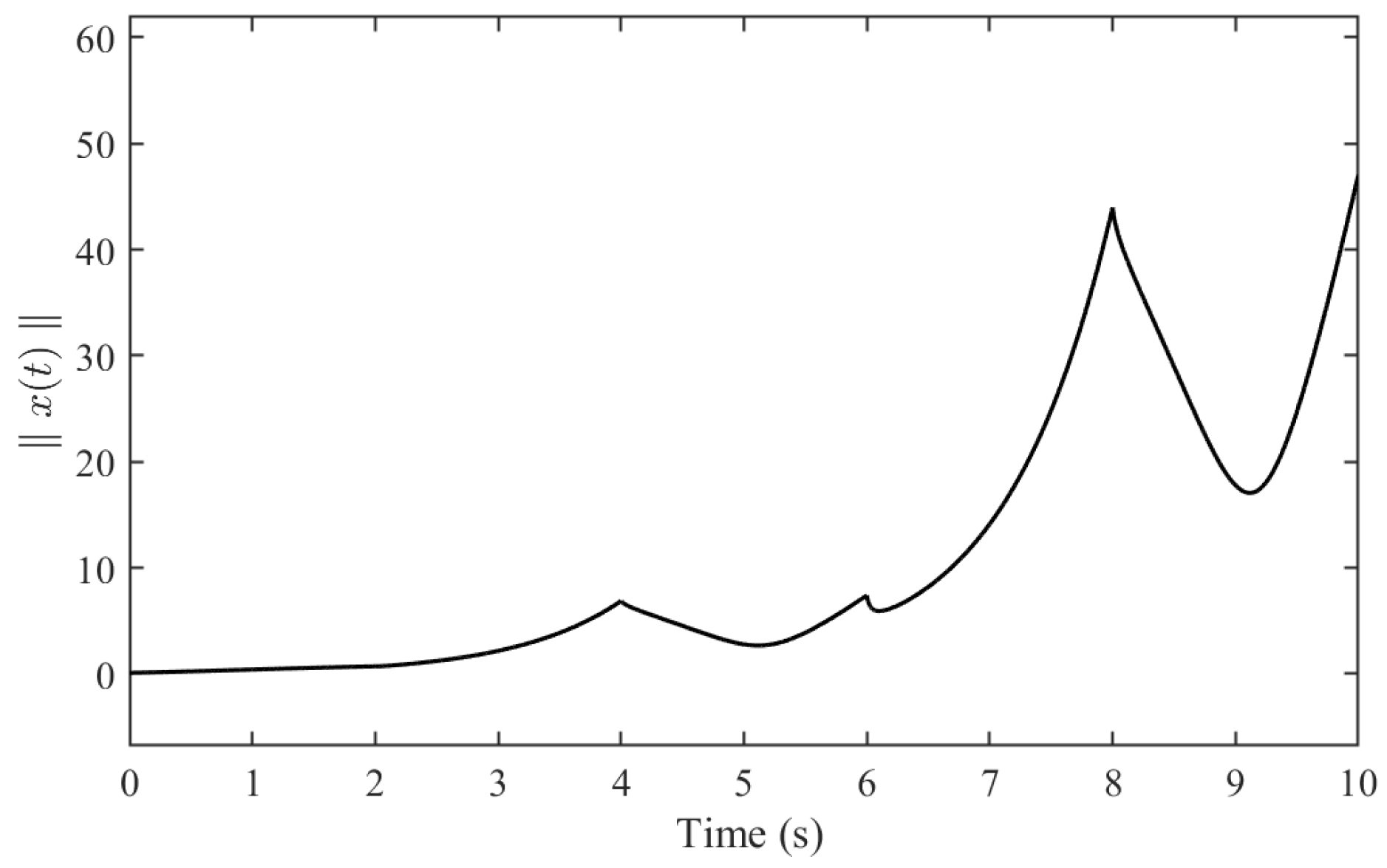Finite-Time Stability of Fractional-Order Switched Systems Based on Lyapunov Method
Abstract
1. Introduction
2. Preliminaries and Problem Statement
2.1. Fractional Calculus
2.2. Finite-Time Stability of Fractional-Order Switched Systems
3. Main Results
4. Numerical Examples
5. Conclusions
Author Contributions
Funding
Data Availability Statement
Conflicts of Interest
References
- Metzler, R.; Glöckle, W.G.; Nonnenmacher, T.F. Fractional model equation for anomalous diffusion. Phys. A Stat. Mech. Its Appl. 2012, 211, 13–24. [Google Scholar] [CrossRef]
- Yang, X.; Liang, Y.; Chen, W. A fractal roughness model for the transport of fractional non-Newtonian fluid in microtubes. Chaos Solitons Fractals 2019, 126, 236–241. [Google Scholar] [CrossRef]
- Efe, M.Ö. Fractional order systems in industrial automation—A Survey. IEEE Trans. Ind. Inform. 2011, 7, 582–591. [Google Scholar] [CrossRef]
- Podlubny, I. Fractional-order systems and PIλDμ controllers. IEEE Trans. Autom. Control 1999, 44, 208–214. [Google Scholar] [CrossRef]
- Yu, M.; Li, Y.; Podlubny, I.; Gong, F.; Zhang, C. Fractional-order modeling of lithium-ion batteries using additive noise assisted modeling and correlative information criterion. J. Adv. Res. 2020, 25, 49–56. [Google Scholar] [CrossRef]
- Li, Y.; Chen, Y.Q.; Podlubny, I. Mittag-Leffler stability of fractional order nonlinear dynamic systems. Automatica 2009, 45, 1965–1969. [Google Scholar] [CrossRef]
- Lu, J.; Chen, Y.Q. Robust stability and stabilization of fractional-order interval systems with the fractional order: The case 0 < α < 1. IEEE Trans. Autom. Control 2010, 55, 152–158. [Google Scholar]
- Duarte-Mermoud, M.; Aguila-Camacho, N.; Gallegos, J. Using general quadratic Lyapunov functions to prove Lyapunov uniform stability for fractional order systems. Commun. Nonlinear Sci. Numer. Simul. 2015, 22, 650–659. [Google Scholar] [CrossRef]
- Abolpour, R.; Dehghani, M.; Tavazoei, M.S. Reducing conservatism in robust stability analysis of fractional-order-polytopic systems. ISA Trans. 2021, 119, 106–117. [Google Scholar] [CrossRef]
- Echenausía-Monroy, J.; Huerta-Cuellar, G.; Jaimes-Reátegui, R.; García-López, J.; Aboites, V.; Cassal-Quiroga, B.; Gilardi-Velázquez, H. Multistability emergence through fractional-order-derivatives in a PWL multi-scroll system. Electronics 2020, 9, 880. [Google Scholar] [CrossRef]
- Clemente-López, D.; Munoz-Pacheco, J.; Zambrano-Serrano, E.; Félix Beltrán, O.; Rangel-Magdaleno, J. A piecewise linear approach for implementing fractional-order multi-scroll chaotic systems on ARMs and FPGAs. Fractal Fract. 2024, 8, 389. [Google Scholar] [CrossRef]
- Dai, Y.; Kim, Y.; Wee, S.; Lee, D.; Lee, S. A switching formation strategy for obstacle avoidance of a multi-robot system based on robot priority model. ISA Trans. 2015, 56, 123–134. [Google Scholar] [CrossRef]
- Lee, Y.; Suh, B.; Min, B.W. A Ka-Band bi-directional reconfigurable switched beam-forming network based on 4×4 Butler matrix in 28-nm CMOS. IEEE Trans. Microw. Theory Tech. 2023, 71, 2479–2487. [Google Scholar] [CrossRef]
- Zhao, X.; Yin, Y.; Liu, L.; Sun, X. Stability analysis and delay control for switched positive linear systems. IEEE Trans. Autom. Control 2018, 63, 2184–2190. [Google Scholar] [CrossRef]
- Li, Z.; Zhao, J. Co-design of controllers and a switching policy for non-strict feedback switched nonlinear systems including first-order feedforward paths. IEEE Trans. Autom. Control 2019, 64, 1753–1760. [Google Scholar] [CrossRef]
- Feng, T.; Wu, B.; Wang, Y.E.; Chen, Y.Q. Input-output finite-time stability of switched singular continuous-time systems. Int. J. Control Autom. Syst. 2021, 19, 1828–1835. [Google Scholar] [CrossRef]
- Du, B.; Wei, Y.; Liang, S.; Wang, Y. Estimation of exact initial states of fractional order systems. Nolinear Dyn. 2016, 86, 2061–2070. [Google Scholar] [CrossRef]
- Feng, T.; Guo, L.; Wu, B.; Chen, Y.Q. Stability analysis of switched fractional-order continuous-time systems. Nonlinear Dyn. 2020, 102, 2467–2478. [Google Scholar] [CrossRef]
- Amato, F.; Ariola, M.; Dorato, P. Finite-time control of linear systems subject to parametric uncertainties and disturbances. Automatica 2001, 37, 1459–1463. [Google Scholar] [CrossRef]
- Kilbas, A.A.A.; Srivastava, H.M.; Trujillo, J.J. Theory and Applications of Fractional Differential Equations; Elsevier: New York, NY, USA, 2006. [Google Scholar]
- Zhang, Y.; Wu, H.; Cao, J. Global Mittag-Leffler consensus for fractional singularly perturbed multi-agent systems with discontinuous inherent dynamics via event-triggered control strategy. J. Frankl. Inst. 2021, 358, 2086–2114. [Google Scholar] [CrossRef]
- Ma, Y.; Wu, B.; Wang, Y. Finite-time stability and finite-time boundedness of fractional order linear systems. Neurocomputing 2016, 173, 2076–2082. [Google Scholar] [CrossRef]
- Ye, H.; Gao, J.; Ding, Y. A generalized Gronwall inequality and its application to a fractional differential equation. J. Math. Anal. Appl. 2007, 328, 1075–1081. [Google Scholar] [CrossRef]
- Delavari, H.; Baleanu, D.; Sadati, J. Stability analysis of Caputo fractional-order nonlinear systems. Nonlinear Dyn. 2012, 67, 2433–2439. [Google Scholar] [CrossRef]
- Yang, Y.; Chen, G. Finite-time stability of fractional order impulsive switched systems. Int. J. Robust Nonlinear Control 2015, 25, 2207–2222. [Google Scholar] [CrossRef]
- Zhou, L.; Ho, D.W.C.; Zhai, G. Stability analysis of switched linear singular systems. Automatica 2013, 49, 1481–1487. [Google Scholar] [CrossRef]




Disclaimer/Publisher’s Note: The statements, opinions and data contained in all publications are solely those of the individual author(s) and contributor(s) and not of MDPI and/or the editor(s). MDPI and/or the editor(s) disclaim responsibility for any injury to people or property resulting from any ideas, methods, instructions or products referred to in the content. |
© 2025 by the authors. Licensee MDPI, Basel, Switzerland. This article is an open access article distributed under the terms and conditions of the Creative Commons Attribution (CC BY) license (https://creativecommons.org/licenses/by/4.0/).
Share and Cite
Feng, T.; Wang, L.; Chen, Y. Finite-Time Stability of Fractional-Order Switched Systems Based on Lyapunov Method. Fractal Fract. 2025, 9, 94. https://doi.org/10.3390/fractalfract9020094
Feng T, Wang L, Chen Y. Finite-Time Stability of Fractional-Order Switched Systems Based on Lyapunov Method. Fractal and Fractional. 2025; 9(2):94. https://doi.org/10.3390/fractalfract9020094
Chicago/Turabian StyleFeng, Tian, Lizhen Wang, and Yangquan Chen. 2025. "Finite-Time Stability of Fractional-Order Switched Systems Based on Lyapunov Method" Fractal and Fractional 9, no. 2: 94. https://doi.org/10.3390/fractalfract9020094
APA StyleFeng, T., Wang, L., & Chen, Y. (2025). Finite-Time Stability of Fractional-Order Switched Systems Based on Lyapunov Method. Fractal and Fractional, 9(2), 94. https://doi.org/10.3390/fractalfract9020094






